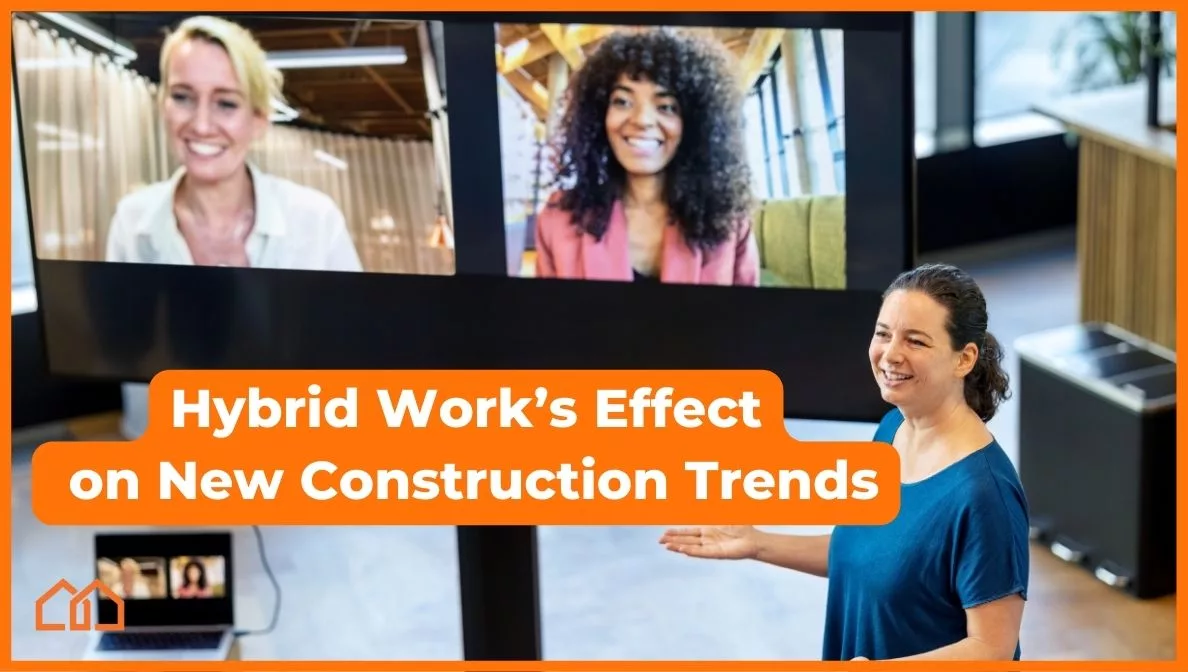What is hybrid work, and how is it influencing new construction?
In 2024, hybrid work is becoming one of the more popular work models as the demand to work from anywhere has increased by over 500% since the pandemic. The hybrid work schedule has changed the way we imagined the workweek would look, including how we shop for a suburban family home.
This creative work option has allowed people to enjoy flexible schedules and fewer commutes while still meeting their daily goals. Even though the pandemic restrictions have eased, the chance to work hybrid or remote remains one of the most desirable benefits for applicants that seek a long-term position.
The Hybrid Work Model Effect
How we work and where we work greatly influence where we live. Needless to say, the ability to work from home and reduce commute times has changed what people want regarding their homes. According to the recent study Hybrid Working, Commuting Time, and the Coming Long-Term Boom in Home Construction by Jordan Rappaport, a senior economist at the Federal Reserve Bank of Kansas City, the option to hybrid work will keep suburban single-family home (SFH) construction in high demand for years to come.
As the number one brokerage for new home construction, Marketplace Homes is excellently positioned to connect buyers to builders. This study about hybrid work helps us anticipate the future and stay on top of trends that will benefit our clients for years. What are the key details, and how can builders stay ahead of the curve regarding new home constructions influenced by hybrid work?
What Is Hybrid Work?
Working hybrid is a blend of remote and in-person work in a physical office space. This trend evolved from the sudden onset of remote work during the pandemic. Workers quickly caught onto how convenient working remotely could be for their work-life balance. The greater flexibility to handle random errands like home repairs and school pick-ups improved the employee experience across the board. However, remote working wasn’t a one-size-fit-all for every professional.
For example, highly collaborative teams still benefit from meeting in-person at least once or twice a week. In these cases, collaboration tools were helpful when remote, but a physical team building experience could enhance office work in select industries and departments within a company. Enter the hybrid work environment, where professionals can collaborate in person a few days per week then do other tasks at home for a couple other days.
For this reason, hybrid working became another option for people who can meet most goals at home and but collaborate on-site on occasion. Every organization is still finding its rhythm in this regard, with some creating fixed hybrid schedules while others allow the option for remote days as needed. There may also be fully remote employees, especially if the company finds an employee from out of state who does not need to be present physically to complete the job.
Hybrid Workspaces’ Influence on Commute Times
People start to reconsider where they want to live when commute times are slashed in half or eliminated altogether. If they have a longer commute but don’t have to do it daily, they may feel like they can tolerate living farther away from their job.
Or, if someone works entirely remotely, they can move to a cheaper area and get a lot of house for their dollar. All things considered, this new report about the rising demand for new home construction in metropolitan suburbs makes a lot of sense.
Suburban Family Home Trends and The Hybrid Workplace
According to Rappaport’s study, evidence strongly suggests that fewer commutes can boost single family home construction in the long term, especially in major metropolitan areas. Namely, new construction is slated to triple in high-demand places like New York and Philadelphia, where residents historically lived in the city to reduce their commute in exchange for higher real estate prices.
However, as workers are more willing to live farther from work, they vacate areas previously packed with locals. When you don’t need to go to work five days a week, the idea of moving to the suburbs is more tolerable, as well as the longer commute to work in-office that happens less frequently. Hybrid work also still tethers the worker within their workplace’s general area, unlike remote workers who can move anywhere in the country.
Predictions Regarding Hybrid Work
Rappaport’s study doesn’t just look at short-term post-pandemic trends but figures in the long-term impact of forever-changed work schedules. Though mortgage applications and new build contracts are indeed decreasing due to rising interest rates, the benefits of working hybrid in the suburbs from the city still stand:
- Lower house prices
- Larger homes for less money
- Fewer commutes make longer, occasional commutes tolerable.
- Savings in gas, clothing, take-out food, and childcare
- Less time in traffic
- Better work-life balance
Therefore, Rappaport suggests that these benefits will win and continue to fuel single-family home construction outside of major metropolitan areas. The push to move outward will be less urgent for workers in not-as-congested regions. However, the remote and hybrid work trends can influence more sprawl there too.
Long Commutes Have Less Impact
When in-person work reigned supreme, the thought of living far away from work meant grueling battles with traffic and late evening homecomings. This put a strain on work-life balance and made it tough for individuals to commit to living too far away from work.
Families sacrificed space and accepted higher costs to live in the central business district of cities to have more time back at the end of the day. For this reason, a beautiful, larger home in the suburb would not have been the first choice, even if it were more affordable. However, the tables have turned now that it’s possible to stay home a few days of the week.
The Hybrid Model: Friendlier on Commutes
Long commutes that don’t happen daily aren’t as disruptive. The families that once turned down larger, cheaper homes due to long commutes will think twice before looking at the city. As more businesses adopt hybrid and remote work options for their workforce, buyers are taking note – and so are builders. Everything from location to floor plan will be affected. For instance, larger homes with home offices will be part of the expected instead of the “luxurious.”
Rappaport suggests that single family homes will gain more momentum due to these trends and will likely remain in high demand for many years. However, growth must be taken in stride with peripheral development as roads must be expanded, along with utility capacity, new schools, and local amenities established to make the quality of life in the suburbs attractive to new homeowners.
Hybrid Work vs. Fully Remote Work: What is The Future of Work?
It’s important to note that hybrid worker real estate activity is more predictable than fully remote employees. While hybrid employees must still return to the office in person occasionally, full-time remote employees have zero geographic tethers and can choose to live wherever they have reliable internet. This compels many remote employees to choose homes in affordable markets for cost savings.
Builders must pay attention to employer activity and keep a steady pulse on what their buyers want. It is also possible for fully remote workers to want to be a short drive away from their employer for social events and occasional company-wide meetings. Exploring buyer demand in a specific area will benefit builders greatly before breaking ground.
Adapting To Higher Interest Rates
Another caveat for builders is navigating the trend of rising interest rates. The extreme housing shortage of 2021-early 2022 has pushed real estate prices up, and rising interest rates have yet to cool these numbers officially.
As a result, affordability has decreased, which has reduced the number of new home construction contracts. Currently, there have been 11 interest rate hikes which continue to negatively affect housing affordability.
Rappaport suggests that as long as mortgage interest rates remain above mid-2022 levels, builders may need to adjust their development strategies in these ways:
- Offer a mix of standard and less expensive homes.
- Employ more affordable production techniques like modular construction.
By thinking outside of the box and understanding the buyer’s needs, builders can still offer products that can benefit their clients.
The Future of New Suburban Family Home Construction Is Here
Rappaport’s study shows good correlations between suburban development in metropolitan peripheries and hybrid work’s rise. Reduced commutes remove the negative aspects of living farther away from central business districts. Sprawl that the hybrid workforce can more readily tolerate than a fully in-person team is likely to continue.
In addition, stats from Gallup at the end of 2023 show that half of remote-capable employees prefer hybrid work. The benefits of hybrid work are evident, as it gives team members the flexibility and collaborate company culture they need. It’s a wonderful work arrangement that has become embedded in today’s office culture.
Builders and Hybrid Team Trends
Builders still face challenges, such as decreasing housing affordability, but they can stay ahead of the curve by diversifying their models to include more affordable homes. At the same time, builders can also take heart that evidence points toward more demand for suburban development.
If you’re a builder who wants to save more deals, our special incentive programs take the stress out of buying new construction homes. Marketplace Homes eliminates double moves, double payments, and tricky timelines. We also take away contingencies that can lower lender confidence and save financing. Ask us how we can streamline the new home construction buying process and help you close more deals through creative real estate solutions.
Alicia Persson is a Content Strategist SEO writer at Marketplace Homes, utilizing previous years of experience on real estate teams that specialized in investments and property management. Before she joined Marketplace Homes, she was also a freelance writer for 7 years, leading to a specialization in real estate and home living content for boutique digital marketing agencies. During her writing years, she learned the basics of SEO and gained experience writing for many different clients, making her versatile at creating diverse content.
She is a proud University of Virginia master’s graduate and enjoyed her undergraduate years at the University of Mary Washington. When Alicia is not writing, she plays keytar and sings in a local 90’s rock cover band, or she spends time with her amazing family.

